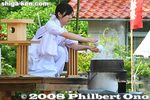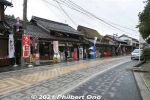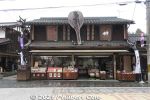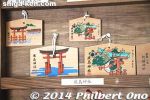 Image search results - "taga-cho" Image search results - "taga-cho" |

Held during Aug. 3-5 at Taga Taisha Shrine, the Mantosai or 10,000-Lantern Festival is a night festival when numerous lanterns are lit within the shrine grounds. The lanterns are for the repose of ancestral spirits.
|
|

Taga Taisha Shrine torii near Taga Taisha-mae Station. MAP
|
|

Road to Taga Taisha Shrine
|
|

Homes along the way are decorated.
|
|

Near the shrine entrance are the usual food stalls.
|
|
|

Welcome to Taga
|
|

Taga Taisha Shrine torii
|
|

Mantosai sign under the torii
|
|

Arched bridge leading to shrine gate.
|
|
|
|
|
|

Kids carrying mikoshi portable shrine. They went to the train station.
|
|

Taga Taisha's lanterns come in five sizes. Each one represents a donation. The donar's name is on the lantern. The biggest lantern requires a donation of 20,000 yen.
|
|

Each lantern is lit with a small lightbulb. (No candles)
|
|

Festival schedule, starting at 5:30 pm and ending after 9 pm.
|
|
|

Approaching the main shrine hall.
|
|

These lanterns above are the smallest ones, requiring a donation of only 1,500 yen. They are the most numerous.
|
|

Main shrine hall
|
|

These lanterns hanging in the main shrine hall must be the most expensive ones.
|
|

The shrine also recently got its roof rethatched. The roof looked spanking new.
|
|

As evening approaches, the crowd increases.
|
|

Torii with lanterns lit
|
|

Gate to shrine
|
|
|

Direct path to Taga Taisha Shrine hall
|
|

Lanterns at night
|
|
|
|
|

Entertainment on stage
|
|
|

Entertainment with a dragon dance
|
|
|
|
|
|
|

Dragon dance
|
|
|
|

Shishimai lion dance
|
|

Lantern-lit path to Taga Taisha
|
|

Taga Taisha Shrine's torii is festooned with red banners reading " Taga Taisha O-taue Matsuri" or Rice-Planting Festival. Held on the first Sunday in June at 1 pm at the shrine. MAP
|
|

Near Taga Taisha Shrine is the sacred rice paddies divided by a cross in the middle to form the kanji "ta" (田) which means rice paddy. This is the site of the rice planting festival starting at 2 pm. A 500 yen donation is required to go inside
|
|
|

Taiko drum troupe from Maibara enters the sacred rice paddy and head for the stage.
|
|

They performed the Rich Harvest Taiko Dance (Honen Taiko Odori). 豊年太鼓踊り 国指定無形文化財
|
|

The Rich Harvest Taiko Dance (Honen Taiko Odori) is an Intangible Cultural Property. Also see my YouTube video here. 豊年太鼓踊り
|
|

The music was a mixture of taiko drums, flutes, and a gong. They performed for about 30 min. 国指定無形文化財
|
|

It was a marvelous performance. Although I think it would've been more impressive if they performed on the ground beside the paddies.
|
|

At around 1:45 pm, a procession of priests and the 70 rice planters entered.
|
|

Spectator tents were set up on both sides of the rice paddy. There weren't so many people. Not all the benches were filled.
|
|

The 70 rice planters are junior high school girls in colorful costumes. They are called Taume. 田植女
|
|

Priests and taume girls enter the paddy.
|
|

Taume rice planters at the Taga Taisha Rice-planting Festival. 田植女
|
|

These girls will sing the rice-planting song. 歌女
|
|

The procession encircle the paddies.
|
|

Taume girls proceed while holding rice seedlings.
|
|

Singer with a tall flower hat.
|
|
|
|

The taume girls take their places.
|
|

The cross at the center.
|
|

Hat problem.
|
|

After everyone is in place, on the stage, the Oyushiki ceremony is performed to purify the sacred rice paddies. 御湯式
|
|

Oyushiki ceremony is performed to purify the sacred rice paddies during the Taga Taisha Rice-Planting Festival. 御湯式
|
|

The ceremony has a pot of boiling water.
|
|

She pours sacred sake into the boiling pot.
|
|

Oyushiki ceremony is performed to purify the sacred rice paddies during the Taga Taisha Rice-Planting Festival. 御湯式
|
|

She dips two green branches into the pot, then...
|
|

She flings the branches backward over her head, creating a spray of hot water. She did this a few times. Also see my YouTube video here.
|
|

On the lower right, the guy in blue tries to shield himself from the spray of boiling water. The crowd laughed.
|
|

Rice seedlings await.
|
|
|

Rice-planting dancers sit through the Oyushiki ceremony.
|
|

After the Oyushiki, the singers on stage start singing the rice-planting song. 御田植歌
|
|

The taume girls enter the rice paddy at about 2 pm.
|
|
|

Taume girl at the Taga Taisha Rice-planting Festival
|
|

The taume girls start to plant the rice seedlings to match the tune of the rice-planting song sung by the girls on stage.
|
|
|
|

They plant the rice seedlings while walking backwards in the ankle-deep mud.
|
|

Now you know why some old Japanese women crouch when they walk. They used to plant rice. Of course, these days, most rice is planted mechanically.
|
|

Besides the rice planters, there are rice-planting dancers who dance along the paddy's perimeter. They dance to the rice-planting song sung on stage. 御田植踊
|
|

O-taue odori dancers
|
|

Otaue odori dancer at Taga Taisha Rice-planting Festival (O-taue Matsuri).
|
|

The rice-planting dancers stay out of the mud. They took a break twice or so, but the rice planters had to continue non-stop.
|
|

The boys in blue on both ends are holding a string to serve as a guide for planting the seedlings in a straight line.
|
|

The rice paddy is not in a scenic location. Being next to a busy road, it was quite noisy.
|
|

I feel sorry for the launderer of the costumes after they finish.
|
|
|

Taume rice-planting girl at Taga Taisha Rice-planting Festival, Shiga Prefecture.
|
|
|
|

Keeping the hat on seemed to be common problem.
|
|

These two girls did away with the hat which could not stay on.
|
|

On stage, shrine maidens perform the Yuminomai Arrow Dance. 弓の舞
|
|

O-taue rice-planting dancers take a break.
|
|
|
|

The singers stopped singing and just watched.
|
|

The work continues, without the singing and dancing.
|
|

Girl planting rice, Taga Taisha O-taue Matsuri, Shiga Prefecture
|
|

Rice seedlings in hand
|
|
|

Nearing the end. However, they did not finish planting the entire paddy. They ended the festival at around 3 pm even though three of the four paddies were still unfinished.
|
|

Washing their hands in a bucket of water.
|
|

Washing their muddy feet.
|
|

At 3:10 pm, they started to leave the rice paddy.
|
|

Taume rice planting girls leave the rice paddy.
|
|
|
|

Unfinished work.
|
|

This paddy is unfinished, but looks pretty neat.
|
|

This unfinished paddy looks pretty messy. I think they should've finished planting all the paddies before ending the festival. Only one of the four paddies was completed.
|
|

The shrine priests and taume girls return to Taga Taisha Shrine.
|
|
|

Muddy pants. Passers by exclaimed, "Look at their feet!"
|
|
|

The shrine priests and taume girls return to Taga Taisha Shrine.
|
|

The Taiko Drum troupe from Asahi, Maibara pose for a photo in front of the taiko bridge at the shrine.
|
|

Ohmi Railways Taga Taisha-mae Station. The shrine is a 10-min. walk from this station. 近江鉄道 多賀大社前駅 MAP
|
|
|

Exhibition space inside Taga Taisha-mae Station. Also good as a waiting room.
|
|

Taga Taisha-mae Station's waiting room also has a showcase
|
|
|
|
|
|

Bicycles are allowed on Ohmi Railways trains.
|
|

Loading a bicycle on the train.
|
|

Bicycles are allowed on Ohmi Railways trains.
|
|

Torii near the train station.
|
|
|

Way to Taga Taisha.
|
|

Local shop in Taga.
|
|

Ohmi Railways Taga Taisha-mae Station. The shrine is a 10-min. walk from this station. 近江鉄道 多賀大社前駅
|
|

Exhibition space inside Taga Taisha-mae Station. Also good as a waiting room.
|
|

When there's no exhibition inside Taga Taisha-mae Station, it's a nice waiting room.
|
|

Taga Taisha-mae Station's waiting room also has a showcase of ema prayer tablets from various shrines.
|
|

Taga Taisha-mae Station's waiting room also has a showcase of ema prayer tablets from various shrines.
|
|

Taga Taisha-mae Station platform and Ohmi Railways train.
|
|

Inside Ohmi Railways train.
|
|

On the ceiling of Taga Taisha-mae Station, there are sparrow (or are they swallows?) bird nests. This one had chicks waiting for its mother.
|
|

Here's the mother flying in to feed her young.
|
|

This was in May, and these birds often make nests in train station and even public restrooms where people often come and go. The people protect them from predators such as crows. And their nests are too high for people to reach.
|
|

Some kind of new monument in front of the train station.
|
|

Taga Matsuri is held annually on April 22 at Taga Taisha Shrine. It's basically a procession of Shinto priests, children in costume, women warriors, and other people on 40 horses. These photos were taken in 2009.
|
|

Two mikoshi portable shrines in front of the shrine await action. MAP
|
|

A Shinto ceremomy was held at the shrine at 8:30 am.
|
|

Taga Matsuri paper lantern decorated the homes leading to the shrine.
|
|

Girls dressed as shrine maidens pose for a picture. They will join the afetrnoon procession and perform a sacred dance at the Otabisho.
|
|

Shrine maidens
|
|

Closeup of the crown.
|
|

The horses are readied.
|
|

Prayers to the mikoshi portable shrine.
|
|

Phoenix atop the mikoshi.
|
|
|
|
|

The morning procession leaves Taga Taisha at 10:30 am heading for Totonomiya Shrine in Kurusu. It turned out to be pretty far away. 調宮神社 栗栖
|
|

One horse after another leaves the shrine.
|
|
|
|
|
|
|
|

Both mikoshi went over the shrine's steep, arched, stone bridge.
|
|
|
|
|

The main mikoshi leaves Taga Taisha.
|
|

They raise the mikoshi high up.
|
|
|

The procession first goes on a major highway where one lane is closed to traffic.
|
|
|
|

They pass by Taga Taisha's rice paddy where they hold the rice-planting festival in June.
|
|
|
|
|
|
|
|
|
|
|
|

Shrine maiden dancers. 舞女
|
|
|
|
|

We are going way deep into the countryside, toward the mountains in Taga.
|
|

Taga Matsuri Festival on April 22, Shiga Prefecture. 多賀まつり
|
|
|
|
|

The kids wore this cushion-like padding on their backs.
|
|
|

Kurusu in sight. 栗栖
|
|

The procession is led by a police car.
|
|

Banner for Totonomiya Shrine.
|
|

Entering Kurusu.
|
|

We are met with a welcoming committee consisting of bell ringers and the beating of a huge taiko drum.
|
|

Huge taiko drum made a deep sound echoing throughout the place. These men soon got tired beating the drum and took turns.
|
|
|

Bell ringing.
|
|
|

This is the Otabisho at Totonomiya Shrine. The bridge on the left leads to the shrine. We arrived at around 11:40 am. It means we walked for over an hour.
|
|
|

It was a nice place though, with clean rivers and lush greenery.
|
|

Totonomiya Shrine
|
|

Everyone started to arrive.
|
|

Totonomiya Shrine 調宮神社
|
|
|
|

Mikoshi over the bridge to the shrine.
|
|

Mikoshi entering Totonomiya Shrine.
|
|
|

At Totonomiya Shrine, they held a Shinto ceremony.
|
|

Bringing offerings to the shrine.
|
|

Ceremony
|
|

It was then a lunch break until 1 pm. I took the time to walk around the area.
|
|

Before 1 pm, people started preparing for the procession back to Taga Taisha.
|
|
|
|
|
|
|

He must be three years old. One of the youngest photographers I've seen unassisted. I wish I started that young.
|
|

The procession is ready to head back by 1 pm.
|
|

Don't forget the mikoshi.
|
|

Leaving Kurusu.
|
|

Meanwhile, back at Taga Taisha, more people and horses wait to join the procession for the afternoon procession to the Otabisho in Amago, a short distance away.
|
|

The afternoon procession is the main one to leave the shrine at 2 pm. These people will join the morning procession when it arrives here at 2 pm.
|
|

The afternoon procession included these two foxy ladies who supposed to be women warriors on horseback. Also see my YouTube video here.
|
|

Woman warrior on horseback for the Taga Matsuri, Shiga Prefecture. 女武者
|
|

Woman warrior on horseback for the Taga Matsuri, Shiga Prefecture. 女武者
|
|

The morning procession arrives at the shrine.
|
|
|

The women warriors and more people on horseback start to join the procession.
|
|
|
|
|

Taga town mayor.
|
|
|
|
|
|
|
|
|
|

Shrine maiden dancers.
|
|
|

A total of about 500 people were in the procession.
|
|

And there they go to the Otabisho.
|
|

Mikoshi arrives at Taga Taisha and passes by.
|
|
|
|

The main mikoshi also passes by the shrine.
|
|
|
|

The went through the main road of Taga.
|
|
|
|